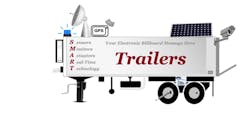In 1985, I started working with the transmission division of Eaton. I was in Wisconsin working for an industrial operation of Eaton on programmable logic controllers, motion controllers, video inspection equipment, and such things. My job was to help bring electronics to the tractor.
At that time, I cannot recall a single computer on the tractor. Today, there are computers for the transmission, brakes, engine, instrument cluster, satellite radio, electronic logging device, air conditioning, mirrors, lights, seats, and more. It’s been an interesting journey down the road to automation, improved freight logistics, improved warranties, and on-time delivery.
Unfortunately, the trailer has been behind the tractor all along. It has, almost literally, been left behind in the progress of automation. Not entirely, though. Trailers have computers for the brakes, the refrigeration unit, and a growing number have telematics for tracking the trailer separately from tracking the tractor. After all, there is an average still of about three trailers for every tractor.
At the Truckload Carriers Association in March, and again at the Technology and Maintenance Council meeting the same month, I participated in panel sessions on smart trailers. One conclusion is that some level of standardization of interfaces is needed as we did in the mid-1980s with the data link which was updated to a faster data link in the early years of this century. The second conclusion is that we are in the growth phase of SMARTs for trailers. Historically, it takes about 30-years for wide adoption of technology in new vehicles, longer to outfit all existing vehicles.
With about 1.2 to 1.4 million trailers with mobile resource management systems on them (according to the latest report on the subject from C.J. Driscoll & Associates), the increased use of trailer tracking alone is expected to nearly double in the next three years.
The automation journey is continuing, since we are not about moving tractors, trucks, boats, planes, trains, or trailers. We are about moving freight and people from Point A to B.
Already, those at the forefront of the application of the technology are using continuous temperature monitoring, checking if doors are open/closed, sensing the load, and checking air pressures.
From my earliest days in this industry, the “hot load” of shrimp was the big issue if the electronics on transmissions failed. The cost of losing that load was significant. Tom Pirnie, president of Grand Island Express, discussed a “hot load” of crab that was rejected by the consignee. He was able to prove the temperature had never been outside limits and was able to reject the claim, saving tens of thousands of dollars.
In the next few years, we will see people providing trailer stability control, lighting control, bulb out sensing, more weight/load sensing, backup cameras, and sensing and controlling lift gates. Before the end of the decade, we will have automated tractors relying on information and controls on the trailer to both improve advanced driver/vehicle assistance systems (ADAS) and move us toward autonomous vehicle operation at some level. 360-degree sensing to avoid accidents and damage will be used. More sensing at the wheel ends will check on temperatures and proper greasing. Landing gear and coupling controls have existed for a decade already and will begin to be used more, making it easier for out industry to employ drivers, just as the automated mechanical transmissions have taken decades to help our industry.
My recommendation to you, is don’t be a skeptical laggard and get on the bandwagon — I mean the trail to SMARTer trailers.
About the Author
Paul Menig
CEO
Paul Menig is the CEO of Business Accelerants, a consulting company focused on helping companies succeed by leveraging technology in their products and processes.
